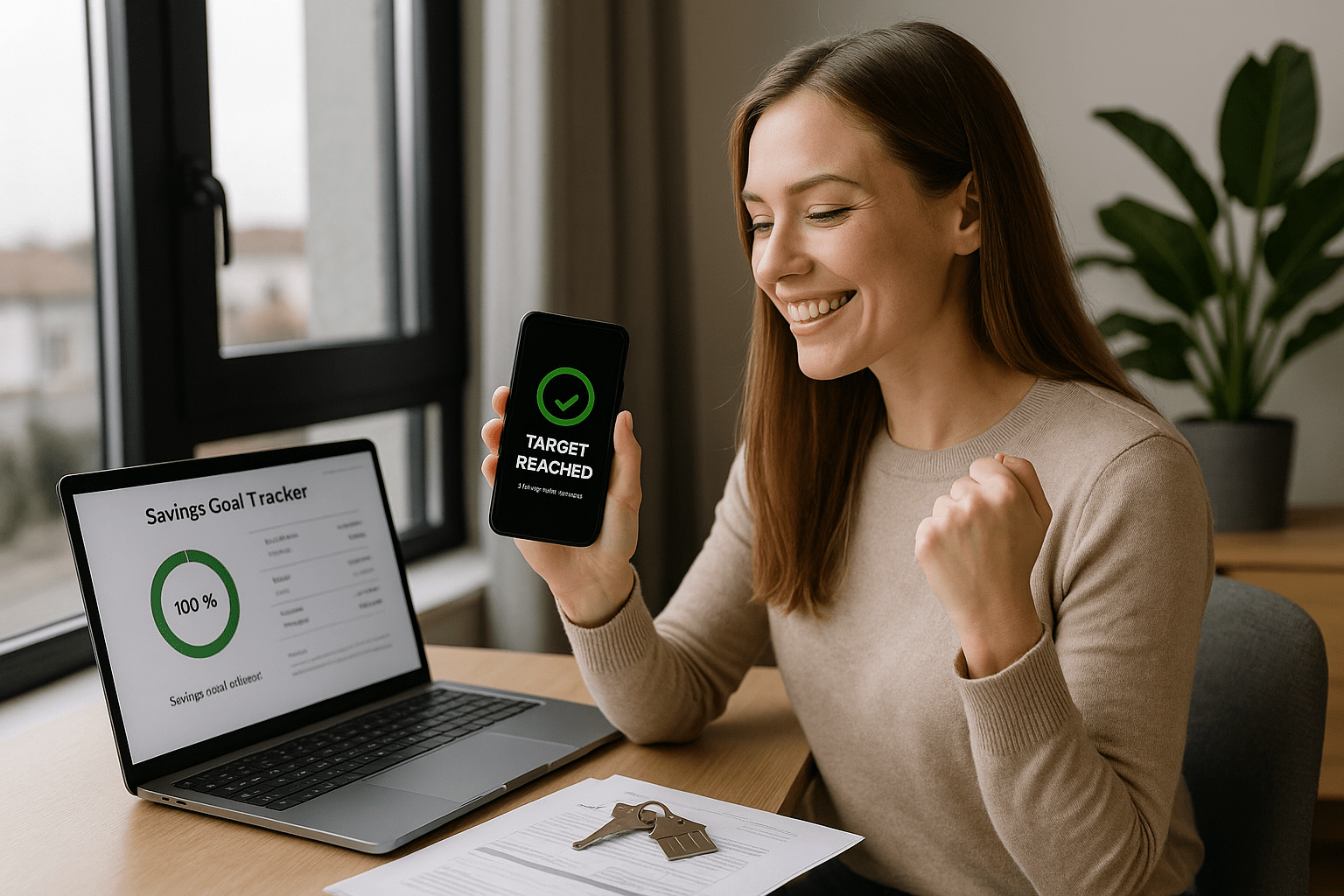How to Save for a House: Your First $10,000 and Where to Keep It
How to Save for a House: Your First $10,000 and Where to Keep It

How to Start Saving Money for Your First Home Down Payment
Whether you’re a parent helping your young adult save for their first home or you’re in your twenties building toward homeownership, that first chunk of savings feels both exciting and overwhelming. The good news? Getting to your first milestone is more achievable than most people think—when you know exactly where to put your money and how to make it work harder.
In this guide, you’ll discover:
- How to save your first goal amount systematically without sacrificing your lifestyle (according to FDIC guidance)
- Where to keep down payment funds so they earn competitive returns (per CFPB recommendations)
- Which account types protect your purchasing power while maintaining access
- How high-yield options can add hundreds or thousands to your savings automatically
- Strategic timelines that turn saving into a achievable monthly habit
The difference between people who save successfully and those who struggle isn’t income—it’s having a clear target and the right place to put every dollar.
Ready to start building your down payment fund? Schedule a call to discuss how much you’ll need and the fastest path to homeownership.
What Makes the First Savings Goal So Important?
Here’s what most financial advice gets wrong: They tell you to save for years before even thinking about buying a home. But the real power of that first significant amount isn’t just about the down payment—it’s about momentum.
When you hit your first major milestone, something psychological shifts. You prove to yourself that homeownership isn’t some distant fantasy. You demonstrate to lenders that you can manage money responsibly. You give yourself options that renters never have.
That first goal typically represents:
- Emergency fund foundation plus down payment start
- Minimum threshold for down payment assistance eligibility
- Qualification buffer that strengthens your mortgage application
- Confidence builder that transforms “someday” into “this year”
The families who succeed aren’t necessarily making more money. They’re putting their savings in places where it grows faster, compounds automatically, and stays protected from impulse spending.
Use the FHA loan calculator to see exactly how much you’ll need for your target home price and how your savings timeline impacts your purchase date.

Where Should You Keep Your Down Payment Savings?
This decision matters more than most people realize. Put your down payment fund in the wrong place and you’ll lose thousands to inflation and opportunity cost. Put it in an account that’s too aggressive and you might not have access when you need it.
The account type hierarchy for home savings:
High-Yield Savings Accounts (Best for Most People):
- Current yields significantly above standard savings rates
- FDIC insured up to applicable limits per depositor
- Instant access when you’re ready to buy
- No market risk to your principal
- Automatic interest compounding
Money Market Accounts:
- Similar yields to high-yield savings
- May offer check-writing privileges
- Often require higher minimum balances
- FDIC insured protection
- Good for larger balances
Certificates of Deposit (CDs):
- Higher rates for locking funds for specific terms
- Best when you have a defined timeline
- Penalties for early withdrawal
- Laddering strategy lets you balance access with yield
- FDIC protected
What to Avoid for Down Payment Funds:
- Standard bank savings accounts (yields far too low)
- Checking accounts (earning nothing while inflation eats value)
- Stock market investments (too volatile for near-term needs)
- Cryptocurrency (extreme volatility risks your timeline)
The right choice depends on your timeline. If you’re buying within twelve months, high-yield savings gives you flexibility. If you’re planning for two to three years out, consider CD laddering for higher returns.
See how different conventional loan down payment amounts affect your monthly payment and help you set the right savings target.
How Much Interest Should Your Savings Actually Earn?
Here’s the math that most young savers miss: The difference between a standard savings account and a high-yield account can add hundreds or thousands of dollars to your down payment automatically.
Real-world comparison:
- Standard bank savings: minimal yield
- High-yield savings: competitive market rates
- Difference on a growing balance over two years: substantial additional funds
Why this matters for home buyers: Every additional dollar in your savings account is another dollar you don’t have to earn through your paycheck. Your money should work as hard as you do.
Interest earnings strategies:
- Open high-yield account immediately when starting to save
- Transfer funds from standard accounts earning almost nothing
- Set automatic deposits so interest compounds on growing balances
- Reinvest all interest earnings rather than withdrawing
- Monitor rates and switch if better options emerge
The compounding advantage: When you earn interest on your deposits plus interest on your prior interest, your savings accelerate. Starting twelve months earlier with high-yield accounts versus standard savings can mean the difference between qualifying for your target home and having to wait another six months.
Use the down payment assistance program finder to see how your savings can combine with grant programs to reach your goal faster.

How Do You Actually Save Your First Significant Amount?
The brutal truth about saving: Motivation gets you started, but systems get you there. Willpower fails when expenses pop up. Automatic transfers succeed when you’re not even thinking about it.
The pay-yourself-first framework:
Week One: Set Your Foundation
- Calculate exact down payment target for your market
- Open high-yield savings account separate from checking
- Set up automatic transfer for every payday
- Make it impossible to “skip” by automating completely
Weeks Two Through Eight: Build the Habit
- Start with manageable amount even if it feels small
- Increase transfer amount as you adjust spending elsewhere
- Track progress weekly to maintain momentum
- Celebrate small milestones to reinforce behavior
Months Three Through Twelve: Accelerate
- Channel any windfalls directly to savings (tax refunds, bonuses, gifts)
- Increase automatic transfer amount with any raises
- Find one expense to eliminate and redirect that amount
- Consider side income specifically designated for home fund
The psychological trick that works: Name your savings account something specific like “My First Home Fund” or “123 Main Street Down Payment.” Seeing the specific goal every time you log in makes it harder to raid for other purposes.
Review this FHA loan case study showing how a physical therapist saved systematically and purchased within eighteen months.
What If You Can’t Save Fast Enough?
This is where most advice stops—but it’s where Smart Stewards strategy accelerates. You don’t need to save the entire down payment from your paycheck alone. Multiple funding sources can combine to get you into a home sooner.
Funding source combinations:
Your Systematic Savings (Primary):
- Automatic transfers building your foundation
- Side income channeled directly to home fund
- Eliminated expenses redirected to savings
- Bonus and tax refund deposits
Family Gift Funds (Secondary):
- Parents or relatives contributing to down payment
- Properly documented according to lender requirements
- Can cover significant portion of needed funds
- Makes homeownership timeline years shorter
Down Payment Assistance Programs (Multiplier):
- State and local grants for qualified buyers
- Forgivable loans that become grants over time
- Employer homebuyer assistance programs
- Can provide thousands in additional funding
The strategic combination: Instead of saving for five years to accumulate everything yourself, you might save for eighteen months while family contributes gift funds and you qualify for a assistance program. Three funding sources combined can cut your timeline dramatically.
Explore down payment assistance case study showing how a teacher combined personal savings with grant programs to purchase a home.

Should You Keep Saving or Start Looking Now?
The question that stops progress: “Am I ready?” Most people wait too long, missing out on months or years of equity building because they think they need more savings than actually required.
Timeline decision framework:
You Should Start the Pre-Approval Process When:
- You have funds for minimum down payment in your loan type
- You’ve saved closing cost cushion or have access to assistance
- Your income is stable and documented
- Your credit score meets program requirements
- Your debt-to-income ratio works for qualification
You Should Keep Saving When:
- You lack emergency fund separate from down payment
- Your employment situation is unstable or changing
- You’re actively repairing credit issues
- You have significant debts to pay down first
- Your market requires larger down payment for competition
The wealth-building consideration: Every month you rent is a month you’re not building equity. If you have enough to qualify for a FHA loan with minimal down payment, starting sooner often builds more wealth than waiting to save a larger amount.
Run the math: Twelve months paying rent: funds disappear forever. Twelve months making mortgage payments: you build equity, gain tax benefits, and capture appreciation. Even with a smaller down payment, homeownership typically wins the wealth-building race.
Use the rental property calculator to see how house hacking strategies can eliminate housing costs entirely while building wealth.
How Do High-Yield Accounts Actually Work?
Many young adults have never opened anything beyond a basic checking account. Understanding how high-yield savings work removes the mystery and shows you why they’re essential for home savings.
The mechanics of high-yield savings:
Interest Calculation:
- Your daily balance earns interest at the stated annual rate
- Interest compounds daily or monthly depending on account
- Higher balances earn more interest (motivating continued saving)
- Rates can change with market conditions
Access and Flexibility:
- Funds typically available within one to two business days
- Transfer to checking account or direct to title company at closing
- No penalties for withdrawals when you’re ready to buy
- Can continue adding funds any time
FDIC Insurance Protection:
- Your deposits protected up to applicable limits per depositor
- No risk to principal from market fluctuations
- Same protection as standard savings accounts
- Peace of mind while your down payment grows
Shopping for best rates:
- Online banks typically offer highest yields
- Traditional banks usually offer lower rates
- Credit unions can be competitive
- Rates change so review options periodically
The automation advantage: Link your checking account to high-yield savings and set automatic transfer on payday. Your down payment fund grows without requiring any decisions or effort after initial setup.

What Happens to Your Savings at Closing?
Understanding the endgame helps you plan the beginning. Your carefully accumulated savings doesn’t just disappear at closing—it transforms into equity and your foundation for wealth building.
How your savings get deployed:
Down Payment:
- Transferred to title company before closing
- Becomes instant equity in your home
- Reduces loan amount and monthly payment
- Shows lenders your commitment and capability
Closing Costs:
- Covers loan origination fees, title insurance, prepaid items
- Can sometimes be reduced through seller concessions
- May be partially covered by lender credits
- Plan for these in addition to down payment
Reserve Requirements:
- Some loan programs require cash reserves after closing
- Demonstrates ability to handle unexpected expenses
- Often equivalent to several months of payments
- Stays in your savings account for emergency access
The wealth-building transformation: That money you saved isn’t gone—it’s invested. Your down payment becomes equity that appreciates with your home’s value. Your monthly payment builds more equity through principal paydown. Your reserve fund provides security while you adjust to homeownership costs.
After closing: Continue the savings habit you built. Channel former rent payment difference into home maintenance fund, additional principal payments, or next investment property down payment.
See how a conventional loan case study shows a physical therapist’s savings journey from renter to homeowner and how their equity grew in the first year.
How Stairway Mortgage Helps You Save Strategically
We understand that saving for a home feels overwhelming—especially when you’re not sure if you’re even on the right track. Our approach helps you save smarter, not necessarily longer.
Our savings strategy support:
Goal Setting Clarity:
- Calculate exact down payment needed for your target market
- Determine optimal loan program for your situation
- Identify down payment assistance you qualify for
- Show you real timelines based on income and expenses
Account Strategy Guidance:
- Recommend where to keep savings for maximum growth
- Explain high-yield options and how to access them
- Help you understand interest earning potential
- Connect you with account types that match your timeline
Funding Source Coordination:
- Guide proper documentation of gift funds from family
- Identify all down payment assistance programs available
- Show how multiple funding sources combine
- Maximize every dollar through strategic planning
Timeline Optimization:
- Show when you have enough to start shopping
- Explain pre-approval process before you have full down payment
- Demonstrate how starting sooner can build more wealth
- Help you avoid oversaving when you could be building equity
Questions about how much to save and where to keep it? Schedule a call to create your personalized savings roadmap to homeownership.
Ready to Start Your Home Savings Journey?
You’ve learned where to save, how much to aim for, and how to make your money work harder. The difference between people who achieve homeownership and those who just dream about it isn’t income—it’s action.
Your next steps:
- Open High-Yield Account: Compare options and open account this week
- Set Up Automation: Schedule automatic transfer for every payday
- Calculate Your Target: Know exactly how much you need for your market
- Get Pre-Qualified: Understand your timeline even before saving full amount
Different paths work for different people:
- Some save aggressively and buy within a year
- Others combine systematic saving with family assistance
- Many start with smaller down payments and build equity faster
- All succeed by taking action rather than waiting for perfect conditions
The young adults who own homes in their twenties aren’t necessarily making more money. They’re making smarter decisions about where to put their savings and when to stop renting.
Get pre-approved to see exactly how much you need to save, or take our discovery quiz to find your fastest path to homeownership.
Frequently Asked Questions
How long does it take to save for a house down payment?
The timeline varies dramatically based on your income, expenses, target home price, and loan program. With minimal down payment programs like FHA loans, some buyers save enough in twelve to eighteen months by combining automatic savings with high-yield account interest. Others using conventional loans with larger down payments might need two to three years. The key is starting with the right savings account and automating transfers so you’re not relying on willpower alone.
Is a high-yield savings account safe for down payment money?
Yes, high-yield savings accounts are FDIC insured up to applicable limits per depositor, providing the same protection as standard savings accounts. The difference is your money earns significantly more interest while maintaining complete safety and liquidity. For down payment funds you’ll need within the next one to three years, high-yield savings offers the ideal combination of growth, safety, and access. Use the FHA loan calculator to see how additional interest earnings can impact your timeline.
Should I invest my down payment savings in the stock market?
For funds you’ll need within three years, the stock market introduces too much volatility risk. You might need your down payment when the market is down, forcing you to sell at a loss or delay your purchase. High-yield savings accounts and CDs provide better options for near-term home purchase funds. Once you own your home and start building equity, that’s when market investments for longer-term goals make more sense. See this down payment assistance case study showing how strategic savings timing impacts purchase readiness.
Can I use money from family members for my down payment?
Absolutely. Gift funds from family members are accepted by most loan programs when properly documented. The donor provides a gift letter stating the funds are a gift with no repayment expectation, and you’ll need to document the money trail from their account to yours. Many buyers combine their systematic savings with family gifts to reach homeownership years sooner than saving alone. Your lender will guide you through the specific documentation requirements for your loan program.
What if I already have savings but in a regular bank account?
Transfer those funds to a high-yield account immediately. Even if you’re just a few months from buying, the additional interest earnings add up. The process typically takes just a few minutes online, and your funds will be available for home purchase exactly when needed. Every dollar earning higher interest is another dollar you didn’t have to work extra hours to save. The sooner you move existing savings to high-yield accounts, the more your money grows.
Also Helpful for Smart Stewards
Related Resources:
- All Available Loan Programs – Explore financing options that match your savings timeline
- FHA Loans – Minimal down payment requirements for first-time buyers
- Down Payment Assistance – Programs that multiply your savings
What’s Next in Your Journey?
Continue building your Smart Stewards foundation:
- Gift Money for Down Payment (Post #9) – Family assistance strategies
- Side Hustles to Make Money (Post #10) – Income acceleration tactics
- 50 30 20 Budget Rule (Post #6) – Foundation budgeting framework
Explore Your Complete Options
Calculate Your Scenarios:
- FHA Loan Calculator – See down payment requirements
- Conventional Loan Calculator – Compare different down payment amounts
- All Calculators – Model every savings scenario
See Real Success Stories:
- FHA Loan Success – Physical therapist’s first home purchase
- Down Payment Assistance Story – Teacher combined savings with grants
- All Case Studies – Every journey documented
Ready to Take Action:
- Schedule a Call – Discuss your savings strategy
- Discovery Quiz – Find your optimal timeline
- Get Pre-Approved – See your exact target amount
Need a Pre-Approval Letter—Fast?
Buying a home soon? Complete our short form and we’ll connect you with the best loan options for your target property and financial situation—fast.
- Only 2 minutes to complete
- Quick turnaround on pre-approval
- No credit score impact
Got a Few Questions First?
Let’s talk it through. Book a call and one of our friendly advisors will be in touch to guide you personally.
Schedule a CallNot Sure About Your Next Step?
Skip the guesswork. Take our quick Discovery Quiz to uncover your top financial priorities, so we can guide you toward the wealth-building strategies that fit your life.
- Takes just 5 minutes
- Tailored results based on your answers
- No credit check required
Related Posts
Subscribe to our newsletter
Get new posts and insights in your inbox.






